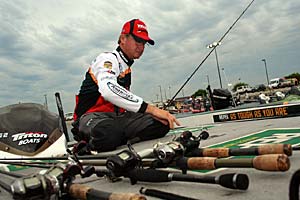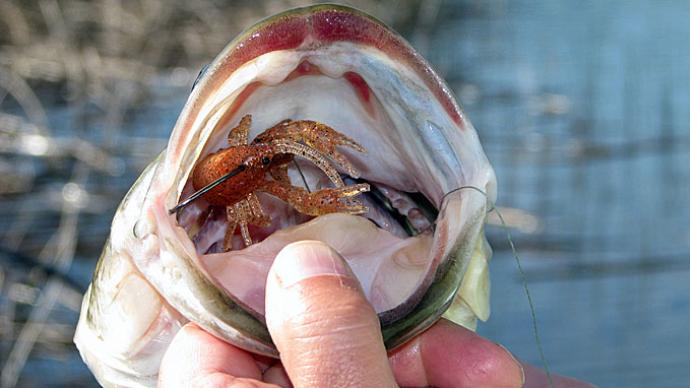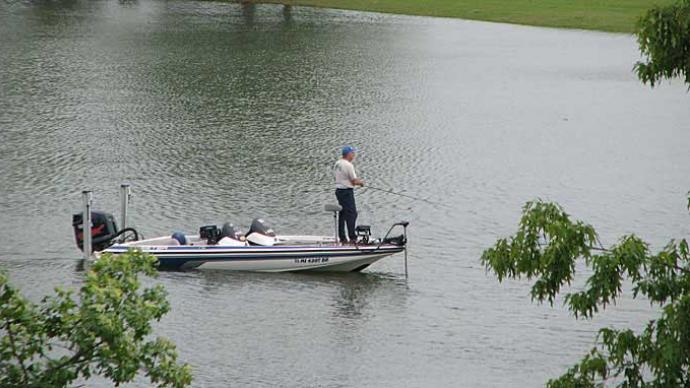
Do you honestly only fish specific lures during each of the year's four seasons? What month is best for bass fishing? Sometimes going outside the expected can be a good strategy.
Although there are only four seasons for anglers, for bass, each season needs to be broken down into fish activity to understand the lure selection, size, and colors.
Winter is probably the most limiting in the lure selection of seasonal patterns. Water temperatures drop to freezing, and the bass' metabolism slows. Because of this, the forage bass feed upon slow way down. Therefore, slow-moving baits and slow presentations work best. The standard lure selection for this time of year would be a jig with a pork or plastic trailer. My second choice is Texas-rigged worms, soft plastic stickbaits, and jigging spoons. Traditional colors for jigs are black/blue, black/chartreuse, and brown. For worms, black/blue, green pumpkin, or watermelon.
Spring needs to be broken down into four segments. Pre-spawn, spawn, post-spawn, and late spring. During pre-spawn, the bass are staging in the eight- to fifteen-foot area, waiting for the shallows to warm. Crankbaits, suspending jerkbaits, lipless crankbaits, Texas rigs, jigs, soft plastic stickbaits, and Carolina rigs work well at this depth. During the spawn, while bass are on the beds, jerkbaits, floating lizards, soft plastic stickbaits, spinnerbaits, shallow crankbaits, and lipless crankbaits are all good choices. In post-spawn periods, bass return to the same depth and areas as pre-spawn, and the same lures will work. Finally, in late spring, bass move into shore early and return to the first structure change later in the morning. It's about the same as an early summer pattern. Spinnerbaits, buzzbaits, soft plastic stickbaits, and lipless crankbaits are good choices this time of year, along with the other spring baits. Springtime colors should be shad and crawfish-related whites, white/chartreuse, reds, and browns.
Summertime means hot days and higher water temperatures. Bass will move near shore early to feed and then return to open water around creek channels or deeper structures. They use these highways to move from shore to points, humps, or sunken islands. They will school together and chase the shad to feed on them. Summer is one of the best times for topwater schooling action. Traditionally this is the best time of the year for plastic worms, soft plastic stickbaits, grubs, lizards, and tube baits, either Texas- or Carolina-rigged. Topwater baits are good early, spinnerbaits work well, and tailspinners and jigging spoons are great for schooling bass. Lipless crankbaits are a good choice also. Worms in black/blue, green pumpkin, watermelon, pumpkin/pepper, and Junebug. Chartreuse/pepper, chrome/blue, white/blue, crawfish, or shad colors for the topwaters, tailspinners and jigging spoons, and white, white/chartreuse, and fire tiger for the spinnerbaits.
Fall means the air and water temperatures begin to cool, and bass will spend more time shallower, feeding up for winter. Fishing in the fall can be more erratic than other times of the year because bass are rapidly transitioning from warm to cold weather. This means that some days you can't get a bite no matter what you throw, and others, you could drop a bare hook in the water and have bass fighting to get there first.
During the fall, bass will go on a feeding frenzy. This usually starts around the first really cool night (frost). Spinnerbaits slow-rolled deep and medium- and deep-diving crankbaits are good along timber lines, stump beds, drop-offs, and main lake points. Jigs, plastic creature baits, soft plastic stickbaits, and lipless crankbaits are all good choices. Colors for crankbaits should be shad, white, and chartreuse. White/chartreuse for spinnerbaits, and red shad, watermelon, pumpkin, Junebug, and chartreuse/pepper for worms and lizards.
Now let's talk about being different. You can't change the way bass change their locations from season to season, but you can change the way you fish, the lures you use, and the color patterns of those lures. The standard for years was a black and blue jig with a pork trailer. How many do you see now with a white jig with a white plastic craw trailer? You can use three baits at just about all depths, fished fast or slow, and come in many different color patterns. You can use these baits all year long. They have caught all sizes of bass. The spinnerbait, Rat- L-Trap, and plastic worm come in many colors, can be fished shallow or deep, and are easy to use. You still need to use shad, perch, and crawfish colors, but you can add something different to give you an edge. Try using a couple of red strands in a white spinnerbait skirt or blue strands in a chartreuse skirt. Use a hot pink or chartreuse marker on the tail of a worm. A worm or grub trailer on your spinnerbait or Rat-L-Trap in a contrasting color might make the difference. You must put something in front of the bass they haven't seen before to give you the edge. Try to think outside the lines of tradition and be different. Be yourself. Use the lures you trust and have confidence in, regardless of the season.
Bonita is sponsored by Cobra Boats, Mercury Motors, Bowie Marine, Hamby's Protectors, Solargizer, Falcon Rods, Bob's Machine Shop, Minn Kota, OutdoorTexas.com, and Tournament Chasers.




